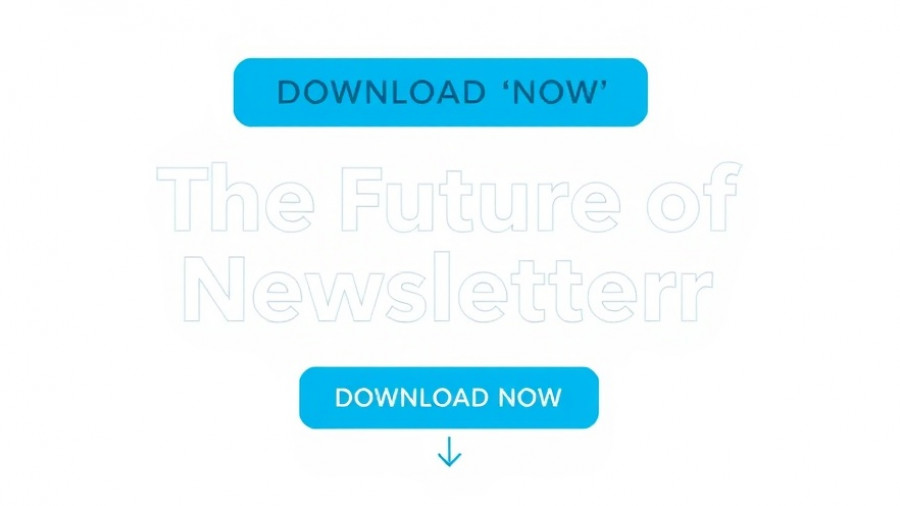
The Resurgence of Newsletters: Why They Matter Now
The landscape of digital communication is shifting, with newsletters stepping into the spotlight once again. A recent report highlights that newsletters are not just making a comeback; they are evolving into a critical component of marketing strategies for small and medium-sized businesses (SMBs). The 2025 State of Newsletters Report, backed by insights from over 400 newsletter professionals, reveals key trends that SMB owners and marketers cannot afford to ignore.
Understanding the Newsletter Comeback
With 88% of people reading their emails daily, newsletters are gaining traction primarily because they offer businesses direct access to their audience. Unlike social media platforms where algorithms dictate visibility, newsletters allow brand loyalty to flourish through personalized, engaging content. The report shows that 25% of newsletter creators achieved significant profit growth in the past year, signaling a vibrant opportunity in this marketing approach.
AI: The Game Changer in Newsletter Marketing
Artificial Intelligence (AI) is reshaping how newsletter creators approach their craft. According to HubSpot's report, 28% of creators use AI for brainstorming ideas, while a quarter utilize it for content generation. This not only streamlines the creation process but enhances the quality of content delivered, making it more relevant and compelling for audiences. Businesses should consider how AI can help them save time and boost engagement.
Adopting Personalization Strategies
As the landscape becomes competitive, personalization is no longer optional. The survey found that newsletters featuring personal opinions and insights have the highest open and click rates, indicating a strong preference for authentic content. Data shows that 7% of non-personalized newsletters struggle with revenue; hence, integrating subscriber demographics for tailored content is crucial for financial viability.
Essential Strategies for Growth and Engagement
To successfully navigate the newsletter revival, SMBs should focus on key strategies identified in the report:
- Content that Resonates: 30% of creators anchor their content strategy on industry opinions, providing a unique voice that attracts subscribers.
- News and Trends: Being informed about platform enhancements (like Substack's new features) and generative AI trends forms the backbone of successful newsletter strategies.
- Distribution Channels: Platforms like LinkedIn and Facebook are emerging as dominant players, eclipsing traditional email for sharing content.
By aligning with these trends, SMBs can better position themselves to grow their subscriber base and improve engagement.
Monetization Strategies: Transforming an Email into Revenue
Many newsletter creators are transitioning their platforms into monetization channels. From paid subscriptions to sponsored content and affiliate marketing, the possibilities are extensive. Successful examples from the industry underline how focusing on a niche audience can lead to profitable ventures. For instance, newsletters like Morning Brew and The Hustle have generated millions by cultivating engaged communities.
Looking Ahead: Predictions for 2025
The future of newsletters lies in adaptability. As messaging becomes increasingly interconnected with AI-driven tools and data privacy regulations evolve, businesses must stay informed about their customers' preferences and behaviors. To thrive, brands need to build transparent relationships with their audiences, combining technology with authenticity.
The HubSpot report serves as a vital resource—it provides the insights needed to not only navigate the current newsletter renaissance but also to leverage it for sustainable success. Now is the time for SMBs in retail, hospitality, and services to harness these insights for building stronger consumer connections.
Conclusion: Seize the Opportunity
To make the most of the newsletter boom, SMBs should invest in understanding their audience, implementing automation through AI, and personalizing their outreach. These elements will enhance customer loyalty while simplifying marketing efforts. Take time to explore the best practices and strategies outlined in HubSpot's comprehensive report—start crafting your roadmap to newsletter success today!
For further insights on creating actionable marketing strategies, consider reading more case studies and resources that detail real-world successes in customer engagement.
 Add Row
Add Row  Add
Add 




Write A Comment